How to Shoot in Manual Mode
Mar 17, 2024 09:30:02 #
Mar 17, 2024 09:40:36 #
Ysarex wrote:
What you provided from Photons to Photos does not refute the fact that raising ISO typically suppresses read noise
It demonstrates it conclusively.

If you looked at that plot your eyes must have glazed over.
Raising ISO typically results in an increase in read noise. The only exception is when a dual gain sensor switches programs.
The article you cherry picked from never said what you claimed. Read it again.
You continue to make yourself look foolish.
Ysarex wrote:
You are not an authoritative source.
I am certainly more authoritative than you ever will be. You are a prime source of half-baked misinformation.
Mar 17, 2024 10:10:05 #
Ysarex
Loc: St. Louis
selmslie wrote:
It demonstrates it conclusively.
Already dealt with: https://www.uglyhedgehog.com/t-802246-2.html#14513555
Trying to rehash wrong and you're still wrong.
You're still whining and throwing juvenile insults and you still have nothing to show. If you were right you'd be able to cite a supporting reference. You haven't done that. I cited five references that prove you're wrong. You're still wrong.
Mar 17, 2024 10:31:36 #
Ysarex wrote:
I cited five references that prove you're wrong.
You haven’t cited a single reference that proved me wrong. What’s more, you have not provided any evidence of your own.
When I provided you with evidence from Photons to Photos (along with my own) you continued to deny that increasing ISO increases read noise. I guess that was just an inconvenient truth that you can’t accept.
This is not working out for you.

Mar 17, 2024 10:36:14 #
selmslie wrote:
I always use full manual because it puts me, not the camera, in control. I'm not perfect but I seldom make mistakes because I know what I want. The camera can't read my mind. It's just a dumb instrument.
I only use the camera's meter as a reference. Highlight warnings are more reliable.
I only use the camera's meter as a reference. Highlight warnings are more reliable.

Mar 17, 2024 10:43:24 #
Ysarex
Loc: St. Louis
selmslie wrote:
You haven’t cited a single reference that proved me wrong.
https://www.uglyhedgehog.com/t-802246-1.html#14513396
https://www.uglyhedgehog.com/t-802246-2.html#14513491
https://www.uglyhedgehog.com/t-802246-2.html#14513555
https://www.uglyhedgehog.com/t-802246-2.html#14513648
https://www.uglyhedgehog.com/t-802246-3.html#14513894
That's five. If you're not wrong then you should be able to cite a supporting reference that refutes the five citations above. You haven't done that. You remain proven wrong.
selmslie wrote:
When I provided you with evidence from Photons to Photos (along with my own) you continued to deny that increasing ISO increases read noise.
So unable to cite a supporting reference you instead try and twist and obfuscate what I said. Or do you have a reading problem? I deliberately used the word suppress. Look it up. I never said ISO prevents read noise or ISO stops read noise. Your Photons to Photos graph has already been dealt with: https://www.uglyhedgehog.com/t-802246-2.html#14513555
You remain proven wrong.
Mar 17, 2024 11:14:44 #
Ysarex wrote:
That's five. If you're not wrong then you should be able to cite a supporting reference that refutes the five citations above. You haven't done that.
That's five references that you simply do not understand. Below is one simple chart that shows once more how read noise increases with ISO.
Ysarex wrote:
I deliberately used the word suppress.
It does not even do that! I demonstrated this using the X100T back on page 3.
The result was not a suppression of noise. It was a wash. The final visible noise was exactly the same in the ISO 200 and 1600 versions. Download the two full size images and look at the difference in noise. It's not visible.
But the downside was a raw file with the shadows so underexposed that they could not be recovered as easily for the ISO 200 version as for the ISO 1600 version. You are better off sticking to ETTR and the higher ISO.
There is enough information in my post for you to replicate the test. Knock yourself out. Prove it to yourself. There is no noise suppression! All of the links in the world will not change that.

Z7 read noise increasing with ISO. Note the discontinuity between ISO 320 and 400 which is typical of a dual gain sensor.
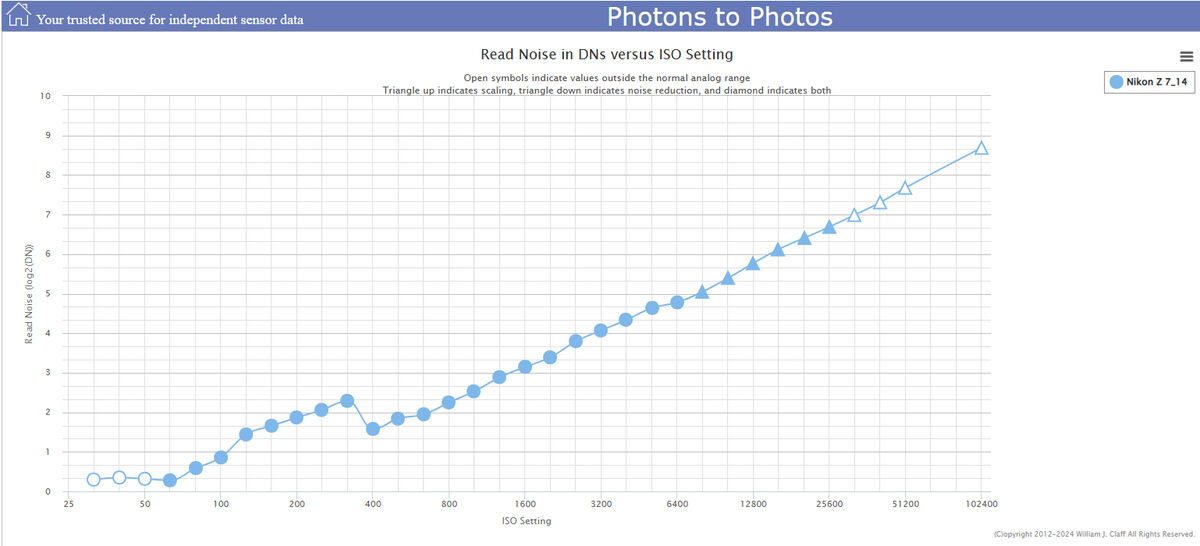
(Download)
Mar 17, 2024 11:33:31 #
Ysarex
Loc: St. Louis
selmslie wrote:
There is no noise suppression!
Here again is proof that you're wrong. Quoting Richard Butler: "... on a camera with higher downstream read noise, increasing the ISO amplification can push all your image data so that it ends up above the level of this camera's downstream read noise. This give a result that's less noisy than shooting at low ISO and brightening the image later, because brightening the dark tones would effectively amplify the downstream read noise." [my bold]
reference: https://www.dpreview.com/articles/0388507676/sources-of-noise-part-two-electronic-noise
That's clear and easy to understand and it proves you're wrong.
If you're not wrong you should be able to cite a supporting reference that refutes Richard Butler quoted above. That was posted on page 1 of this thread and still on page 5 now you've cited nothing to refute it. You remain proven wrong.
Mar 17, 2024 12:46:16 #
Ysarex wrote:
That's clear and easy to understand and it proves you're wrong.
Here is proof that I am not wrong.
I used an A7 III at 1/3200s f/4 and ISO 25600 and 1600 - four stops difference. Both ISO values are above the ISO where the dual gain kicks in so the same gain program is used for both. Aside from the dual gain, the camera is ISO invariant.
The two images show the same level of visible noise. Download both full size images and look at them closely. There is no additional noise suppression happening for the ISO 1600 version. In fact, if you look closely, the ISO 25600 version may look a little cleaner.
RawDigger shows the same problem with the ISO 1600 version - lots of underexposed pixels that cannot be easily recovered.
You have forgotten one of Regan's favorite Russian proverbs, "Trust but verify." It's like your state's motto, "I'm from Missouri." You are not a credit to your state.
I like what I can get from DxOMark and Photons to Photos (same data, more details). I have managed to verify what they are telling us so I know I can trust them.
Your insistence on sources and authorities is misplaced. When you trust them without verifying you end up looking gullible.
ISO 25600
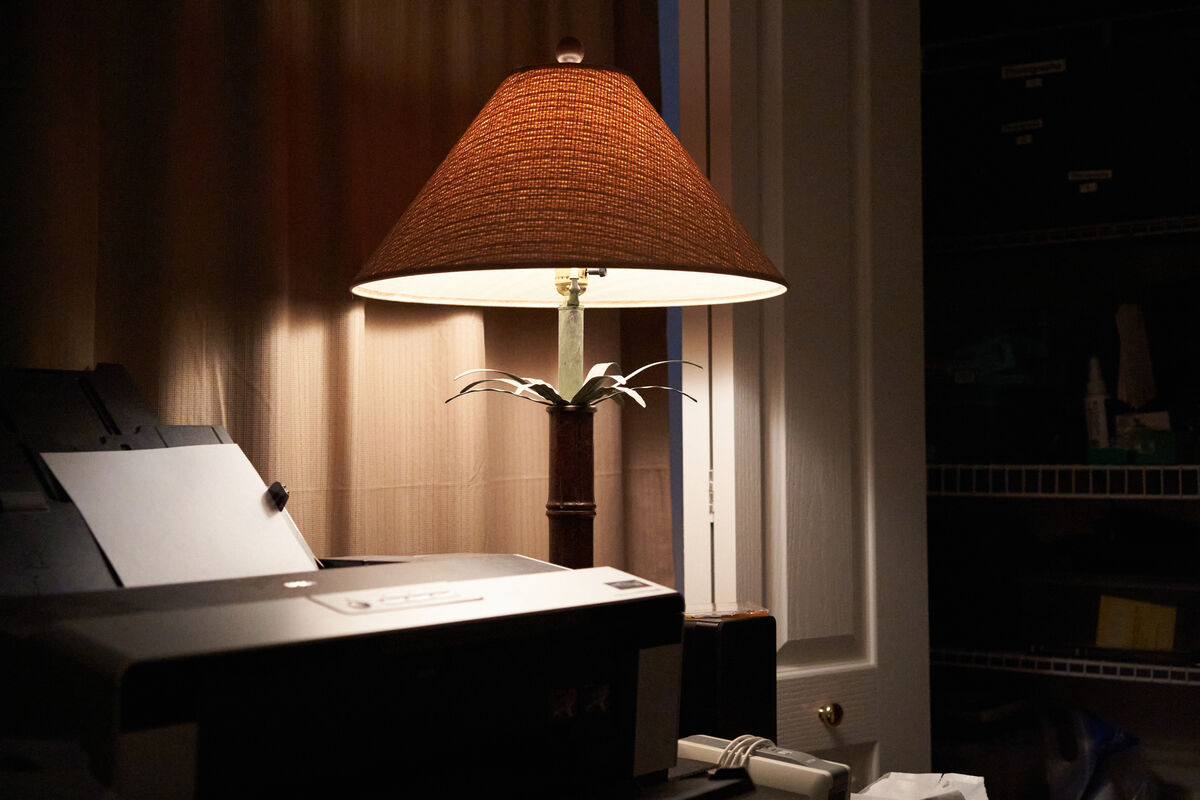
(Download)
ISO 1600, Exposure adjustment +4 in Capture One
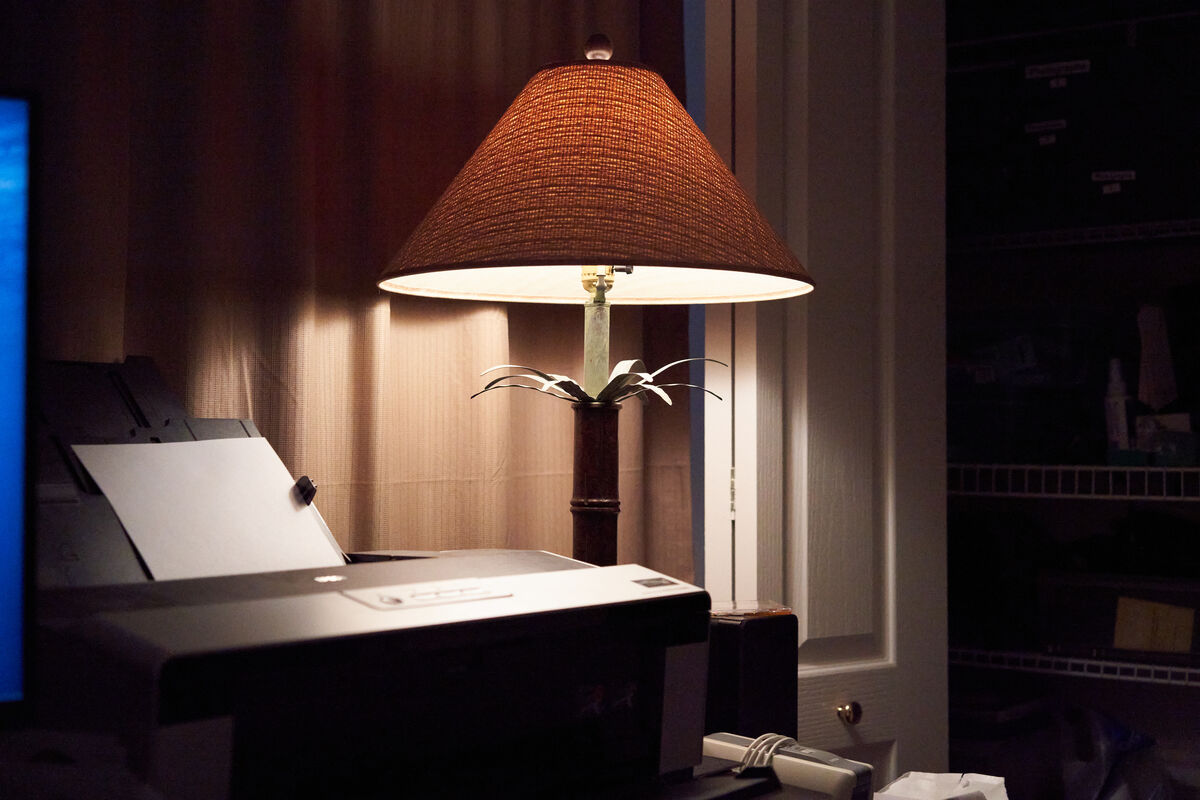
(Download)
ISO 25600 - 2.6K UnExp (underexposed) pixels out ot 24MP
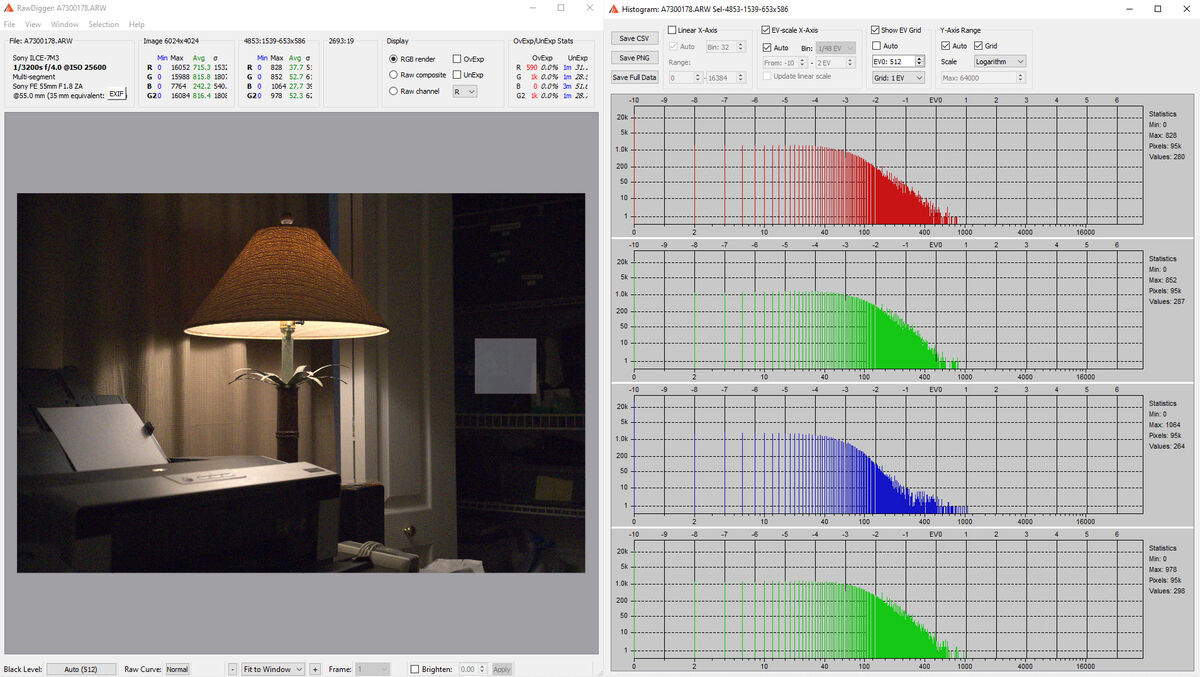
(Download)
ISO 1600 - 17MP UnExp
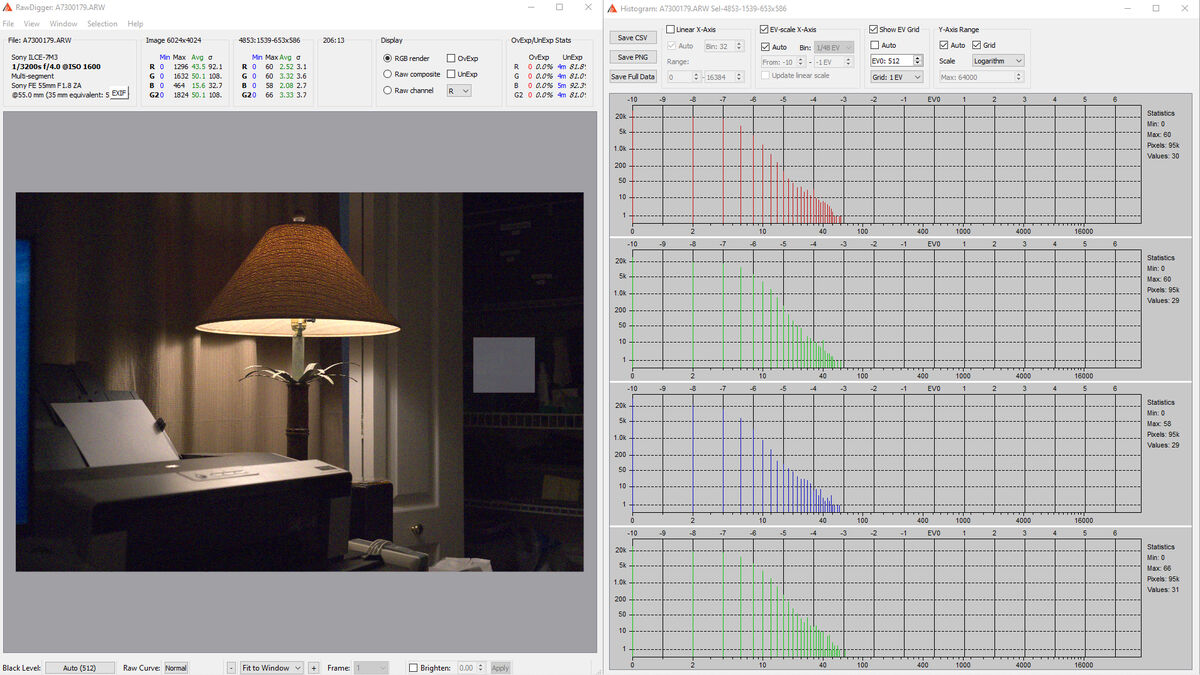
(Download)
Mar 17, 2024 13:11:03 #
Ysarex
Loc: St. Louis
selmslie wrote:
Here is proof that I am not wrong.
Nope.
Still no citation of a reference that refutes what Richard Butler wrote and so you remain proven wrong.
The A7III may be a camera closer to ISO invariant than most (one exception does not invalidate the rule). That's addressed in one of the references that I cited that proves you're wrong -- (already been over this): https://www.uglyhedgehog.com/t-802246-3.html#14513894 Read Richard Butler's response. Most cameras are not fully ISO invariant and as such benefit from downstream read noise suppression as a result of applied amplification to the sensor signal at high ISO values.
NOTE: What I originally said allows for the fact that some cameras are close to ISO invariant: "Raising ISO typically suppresses noise." and so I remain correct.
What you said contains no qualification: "Raising the ISO does not suppress noise. In fact, it increases the read noise..." and you remain incorrect and still proven wrong.
You can't prove you're right with the few cameras you have. Cite a reference to a recognized authority that refutes what Richard Butler wrote or stay proven wrong.
Mar 17, 2024 13:19:16 #
Ysarex wrote:
Nope.
Still no citation of a reference that refutes what Richard Butler wrote and so you remain proven wrong.
Still no citation of a reference that refutes what Richard Butler wrote and so you remain proven wrong.
We don't need citations. We need visible proof.
You can't demonstrate what you claim with a simple test (as I have with two different cameras) because your claim is false.
And you can't point to a fallacy in my demonstration.
We're done here. Goodby.

Mar 17, 2024 14:03:48 #
Ysarex
Loc: St. Louis
selmslie wrote:
And you can't point to a fallacy in my demonstration.
I can't? Did you not say: "There is no additional noise suppression happening for the ISO 1600 version. In fact, if you look closely, the ISO 25600 version may look a little cleaner." The ISO 25600 version may look cleaner because the higher ISO amplification is suppressing downstream read noise. Good job proving you're wrong!
I can also point to what you originally said: "Raising the ISO does not suppress noise. In fact, it increases the read noise..." [my bold] If that were true then in your demonstration the higher ISO 25600 would have increased the read noise beyond the ISO 1600 level, but you just said: "In fact, if you look closely, the ISO 25600 version may look a little cleaner."
This is still only page 5. Maybe on page 6 you can shoot off your other foot!
You remain proven wrong.
Mar 17, 2024 14:11:07 #
Mac wrote:
https://www.lightstalking.com/manual-mode/
I firmly stand with Ysarex and others who call this article BS. BS it is - bad information, bad advice. Unfortunately, what should have been the main points of discussion in this thread were quickly overshadowed by the selmslie-Ysarex mud-wrestling sideshow.
The author of the article elevates use of Manual mode to a ridiculously lofty level of mystique with comments like this:
-- "Learning manual camera settings will be huge for your photography!."
-- "If you come to grips with manual mode, you will....., in terms of technical knowledge, be in the elite few photographers who really know the mechanics of their craft."
-- "It’s very normal to be a little, overwhelmed by manual camera settings. Shooting in manual mode is quite a challenge."
-- ".....gives you ultimate creative control over how your images turn out"
And think about this comment: "Now, shooting in manual mode certainly involves quite a learning curve. You need to understand how the different settings work and how they interact with each other." This should be insulting to most photographers on the lower rungs of the learning ladder. Shouldn't we all learn how camera settings interact, regardless of the shooting modes we use?
Control; the author says: "The main reason to shoot in manual mode is that it gives you a lot of control. Far more than the automatic modes on your camera (like aperture, priority, or shutter speed priority or automatic mode). This means you get to make every mechanical and creative decision that is available to you as a photographer."
What an absurd statement! The implication is that, when in an auto mode, the photographer faithfully accepts what the camera sets. No, the camera suggests, the photographer decides. I use mostly Manual setting (M) with Auto-ISO turned on and Exposure Compensation when needed. Total control!
And what does the author say about how to use the light meter to get a proper exposure when you are in full Manual mode? Nothing. A fine "How to Shoot in Manual Mode" article that is!
Mar 17, 2024 15:52:08 #
Ysarex wrote:
I can't? Did you not say: "There is no additional noise suppression happening for the ISO 1600 version. In fact, if you look closely, the ISO 25600 version may look a little cleaner." The ISO 25600 version may look cleaner because the higher ISO amplification is suppressing downstream read noise.
We are both grabbing the wrong end of the stick.
It really has nothing to do with suppressing the read noise at high ISO (it can't be done). Nothing is being done at high ISO that would not occur naturally. If it could be improved that would already be in the ADC. Besides, the high ISO version of each pair is exposed to the right (ETTR) so the raw file is getting the optimal exposure for that ISO.
The answer is in what is happening to the other image, at the low ISO setting. In both examples the exposure is 3 or 4 stops below ETTR. The RawDigger histograms tell us all we need to know. The quality of the information recorded in the raw file is very poor. That's why I mentioned the difficulty we would have recovering shadow information. But that difficulty is also present when the Exposure slider is moved to the right 3 or 4 stops to equalize the brightness. The result is unavoidably inferior, just as it would be if we tried to recover shadows at that point. The source information is simply too dark and fragmented. A substantial number of pixels are not only underexposed, many of them are 0, 1, 2, 3 or other very small and useless values.
So it's not that the high ISO version is superior. It's that the low ISO version is so inferior that it can make the ETTR version look better.
The penny should have dropped for me a long time ago but at least now I can leave this thread for good.
Mar 17, 2024 16:43:22 #
Ysarex
Loc: St. Louis
selmslie wrote:
So it's not that the high ISO version is superior. It's that the low ISO version is so inferior that it can make the ETTR version look better.
That's your assessment of your A7III.
Regardless, that ISO amplification suppresses downstream read noise is well established fact. I've been aware of that for nearly two decades. The references I cited prove that your statement; "Raising the ISO does not suppress noise. In fact, it increases the read noise..." is wrong. And you've cited nothing to refute that.
If you want to reply, then register here. Registration is free and your account is created instantly, so you can post right away.

